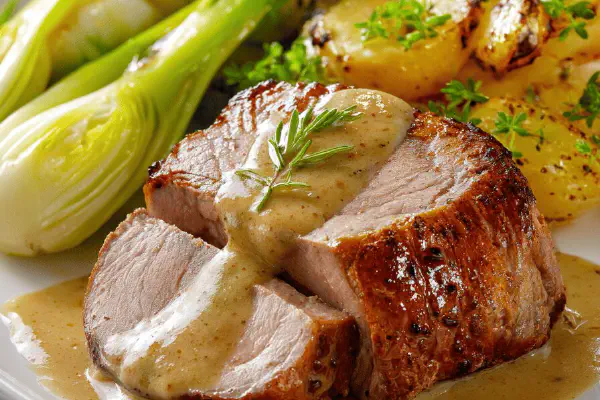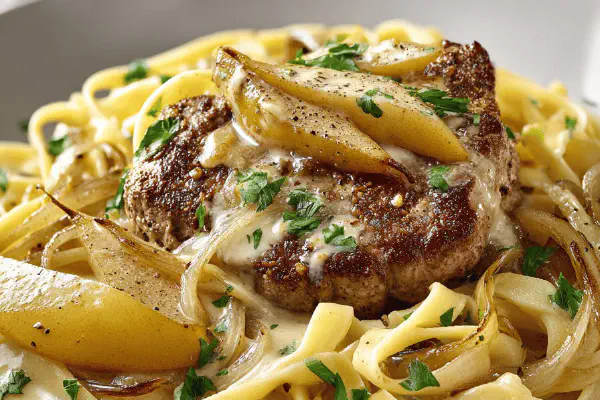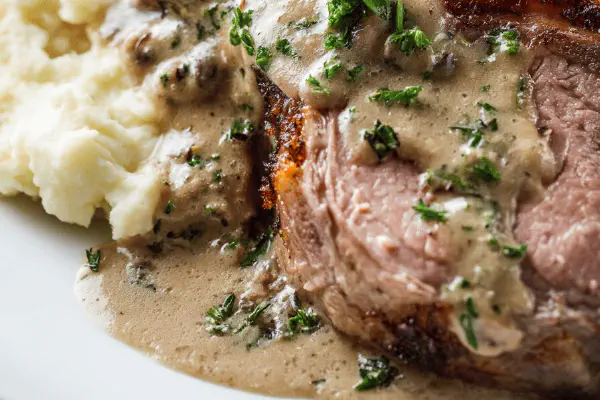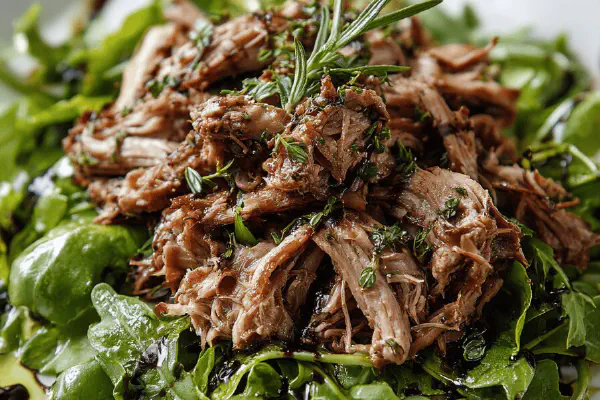Veal Mustard Leeks Roast

By Emma
Certified Culinary Professional
Ingredients
- 4 leeks sliced 2 cm thick
- 80 ml coconut milk or cream 15%
- 80 ml butter
- 1 1.2 kg tied veal sirloin roast (can swap pork tenderloin)
- 25 ml Dijon mustard
- 20 ml olive oil
- 50 ml toasted wheat flour (or all-purpose flour toasted in pan)
- 4 garlic cloves minced
- 700 ml beef or vegetable stock
- Salt and black pepper
About the ingredients
Method
- Set oven rack mid-level. Preheat oven 185°C to 190°C. Oven temps vary; listen, watch carefully.
- Trim leeks, rinse well to remove grit. Cut into thick slices about 2 cm. You want them chunky but tender later.
- In ovenproof dish, scatter leeks. Pour coconut milk or cream over. Dot with half butter. Generous salt and pepper. Cover tightly with foil. This traps steam, cooks leeks gently. Set aside.
- Pat veal dry. Rub all over with Dijon mustard. Salt, pepper aggressively; this crusts during searing.
- Heat oil in heavy skillet, oven-safe if possible, till shimmering but not smoking. Sear veal on all sides. Listen to that sizzle, smell resulting aroma. Should get rich golden color, not burned or pale.
- Transfer roast atop leeks in dish. Place both in oven simultaneously. Roast about 50 min, check temp around 45 min with probe if you have one. Aim for 54°C internal for medium-rare; rises slightly resting.
- When leeks soften, about 40 min, remove foil to brown tops, let moisture evaporate, cook uncovered extra 15 min. Watch color, don't let burn. Leeks will smell earthy, sweet, lightly caramelized.
- Take meat out, transfer to warm plate tented loosely with foil; rest 15 min. Resting lets juices redistribute. Cut test slice if unsure. Pink, moist not bloody.
- While resting, melt remaining butter in saucepan. Add toasted flour and garlic. Stir gently over medium heat till garlic turns light golden, flour smells nutty. Don't brown too fast, garlic bitter if burnt.
- Gradually whisk in stock, add remaining mustard. Keep stirring to avoid lumps. Bring to gentle boil; sauce will thicken to satin texture in about 8-10 min. Taste, season. Can add splash water if too thick, or simmer longer to concentrate.
- Slice roast against the grain. Plate with leeks. Spoon robust mustard sauce over top. Serve immediately with boiled or steamed potatoes, or roasted vegetables.
Cooking tips
Chef's notes
- 💡 Use thick-cut leeks, about 2 cm; thinner slices disintegrate too fast, lose structure during steaming. Rinsing is key—grit likes to hide between layers. Cover foil tight, trap steam; prevents drying but traps aromas too. Remove foil last 15 minutes for subtle caramelization, leeks smell earthy and sweet, watch closely, don’t burn. Timing varies; rely on smell and feel, not only clock.
- 💡 Sear veal on high heat, oil shimmering but not smoking. Mustard rub crusts fast; achieves golden brown, not charred or pale. Crust locks in juices during roast. Salt aggressively before searing; bland meat ruins texture. Heat matters: too low means no crust, too high burns mustard and garlic flavors later. Ovenproof pan saves extra dishes for transfer.
- 💡 Roast at 185°C to 190°C, adjust if oven runs hot. Use probe thermometer from 40-45 minutes to check internal temp—aim 54°C for medium-rare, rest makes it rise further. No probe? Watch color and touch; veal should still feel springy but not squishy. Resting 15 minutes crucial; slice too early and juices leak, dry results. Tent loosely to avoid sweaty crust breakdown.
- 💡 Sauce base needs gentle cooking. Melt remaining butter, add toasted flour slowly; raw flour tastes chalky, weary after past tries. Garlic minced fine; cooks light golden, avoid bitterness. Whisk stock gradually, constant stirring. Simmer 8-10 mins till sauce thickens to velvety, glossy look—too thick? Splash water, too thin? Simmer longer. Taste along, adjust seasoning. Mustard after stock improves balance.
- 💡 Ingredients swaps: pork tenderloin or chicken breast for veal if you want cheaper, quicker roast. Coconut milk in place of cream adds subtle sweetness; dairy intolerance friendly, slight flavor twist. Use grainy mustard for texture, Dijon for smooth. Flour toasted in dry pan brings depth but watch color shifting; too dark, sauce tastes bitter. Butter needed for flavor carry; olive oil alone won’t deliver richness.
Common questions
How to know when leeks are done?
Soft but still hold shape. Covered steaming traps steam; after 40 minutes foil off, brown tops smell sweet and earthy. Overcooked means mushy melting to nothing. Watch aroma and slight browning, not just softness.
Can I use mustard other than Dijon?
Yes, grainy mustard adds texture, Dijon smooth. Swapping affects sauce mouthfeel. Too strong mustard risks bitterness; adjust quantity. Experiment but remember searing crust depends on mustard’s stickiness.
What if roast temp overshoots?
Rest always helps stabilize temp rise; if it's over 54°C, slice thinner, serve immediately—rest times shorter. For dry meat, serve with extra sauce or switch to slower cooking next time. Probe accuracy varies, calibrate often.
How to store leftovers?
Wrap meat tightly, keep separate from leeks if possible. Refrigerate 2-3 days max. Reheat gently in oven or covered pan to avoid drying. Sauce can thicken on standing; add water or stock to adjust. Freezing okay but affects leek texture.



